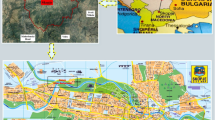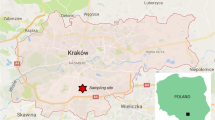Abstract
Indoor air quality depends on the presence of both indoor and outdoor particle sources each of which produces different particles’ size distribution that may have mortality and morbidity effects. Positive Matrix Factorization (PMF) is a mathematical (statistical) procedure for identifying and quantifying the sources of air pollutants at a receptor location. A critical step in PMF is the number of factors determination and the present study aims at discussing this critical issue, by applying PMF on particles size distribution measurements data in a residential environment, in Athens, Greece. A main focal point of the present research is the investigation of the temporal behaviour of the particles size, as recorded in the time series, closely relating the averaging period of the utilised data with the number and type of factors in the PMF. The analysis is based on the estimation of the spectral properties of data and estimation of the integral time scale using the autocorrelation properties of the series. Furthermore, different factor analysis techniques have been applied, namely the rotated Principle Component Analysis (rPCA) and the Independent Component Analysis (ICA) and the results have been compared to PMF results.
Preview
Unable to display preview. Download preview PDF.
Similar content being viewed by others
References
Afshari A, Matson U, Ekberg LE. Characterization of indoor sources of fine and ultrafine particles, A study conducted in a full-scale chamber Indoor Air 15 (2) : 141-150.
Chan LW and Mozurkewich M. (2007) Application of absolute principal component analysis to size distribution data: identification of particle origin.Atmos. Chem. Phys., 7, 887–897.
Chueinta W, Hopke PK, Paatero P. (2000). Investigation of sources of atmospheric aerosol at urban and suburban residential areas in Thailand by positive matrix factorization, Atmospheric Environment 34 : 3319-3329.
Han JS, Moon KJ, Ryu SY, Kim YJ, Perry KD, Han. (2005). Source estimation of anthropogenic aerosols collected by a DRUM sampler during spring of 2002 at Gosan, Korea, Atmospheric Environment 39 (17) : 3113-3125.
Hänninena OO, Lebretb E, I1acquaa V, Katsouyannic K, Künzlid, f N, Sráme RJ, Jantunena M. (2004). Infiltration of ambient PM2.5 and levels of indoor generated non-ETS PM2.5 in residences of four European cities, Atmospheric Environment 38 (37) : 6411-6423.
Juntto S, Paatero P. (1994). Analysis of daily precipitation data by positive matrix factorization, Environmetrics 5 (2):127-144.
Kim E, Hopke PK, Larson TV. (2004). Analysis of ambient particle size distributions using unmix and positive matrix factorization, Environmental Science and Tecnology 38 : 202-209.
Larson T, Gould T, Simpson C, Liu L-JS, Claiborn C, Lewtas J. (2004). Source apportionment of indoor, outdoor, and personal PM2.5 in Seattle, Washington, using positive matrix factorization, Journal of the Air and Waste Management Association 54 (9) : 1175-1187.
Lee E, Chun CK, Paatero P.(1999). Application of positive matrix factorization in source apportionment of particulate pollutants in Hong Kong., Atmospheric environment 33 : 3201-3212.
Morawska L, Salthammer T. (2003). Indoor environment : Airborne particles and settled dust. Weinheim, Wiley-VCH, ISBN: 3-527-30525-43-46.
Ogulei D, Hopke PK, Wallace LA.(2006 [a]). Analysis of indoor particle size distributions in an occupied townhouse using positive matrix factorization, Indoor Air 16 : 204-215.
Ogulei D, Hopke PK, Zhou L, Pancras JP, Nair N, Ondov J. (2006 [b]). Source apportionment of Baltimore aerosol from combined size distribution and chemical composition data, Atmospheric Environment 40 : S396-S410.
Paatero P. (1997). Least squares formulation of robust non-negative factor analysis. Chemometr. Intelligent Lab. Syst. 6037: 23-35.
Polissar AV, Hopke PK, Poirot RL. (2001). Atmospheric aerosol over Vermont: chemical composition and sources, Environmental Science and Technology 35 : 4604-4621.
Ramadan Z, Song X-H, Hopke PK. (2000). Identification of sources of Phoenix aerosol by positive matrix factorization, Journal of the Air and Waste Management Association 50 (8) : 1308-1320.
Rinaldi M, Emblico L, Decesari S, Fuzzi S, Facchini MC, Librando V. (2007). Chemical characterization and source apportionment of size-segregated aerosol collected at an urban site in Sicily, Water, Air, and Soil Pollution 185 (1-4) : 311-321.
Song X-H, Polissar V, Hopke PK. (2001). Sources of particle composition in the north-eastern US, Atmospheric Environment 35 : 5277-5286.
Stone J. (2005). Independence Component Analysis, Encyclopedia of Statistics in Behavioral Science,Wiley & Sons 2 : 907-912.
Thatcher TL, Layton DW. (1995). Deposition, resuspensiion, and penetration of particles within a residence, Atmospheric Environment 29 (13) : 1487-1497.
Wåhlin P, Palmgren F, Van Dingenen R.(2001). Experimental studies of ultrafine particles in streets and the relationship to traffic, Atmospheric Environment 35 (SUPPL. 1) : S63-S69.
Xie YL, Hopke PK, Paatero P, Barrie LA, Li SM. (1999). Identification of source nature and seasonal variations of arctic aerosol by positive matrix factorization, Atmospheric Science 56 : 249-260.
Yakovleva E, Hopke P, Wallace L. (1999). Receptor modeling assessment of particle total exposure assessment methodology data, Environ. Sci. Technol 33 : 3645-3652.
Yatkin S, Bayram A.(2008). Determination of major natural and anthropogenic source profiles for particulate matter and trace elements in Izmir, Turkey Chemosphere 71 (4) : 685-696
Yeung, LL, To, WM. (2004). Size distributions of the aerosols emitted from commercial cooking processes, Indoor and Built Environment 17 (3) : 220-229.
Zhou L, Kim E, Hopke PK, Stanier CO, Pandis S. (2004). Advanced factor analysis on Pittsburgh particle size-distribution data, Aerosol Science Technology 38 (S1) : 118-132.
Zhou L, Hopke PK, Stanier CO, Pandis SN, Ondov JM, Pancras JP. (2005). Investigation of the relationship between chemical composition and size distribution of airborne particles by partial least squares (PLS) and positive matrix factorization (PMF), Geophysical Research, in press.
R. I. Sykes , The variance in time-averaged samples from an intermittent plume, Atmos Env 18 (1984) 121-123
Author information
Authors and Affiliations
Corresponding author
Editor information
Editors and Affiliations
Rights and permissions
Copyright information
© 2009 Springer-Verlag Berlin Heidelberg
About this paper
Cite this paper
Saraga, D.E. et al. (2009). An investigation of the parameters influencing the determination of the number of particulate matter sources and their contribution to the air quality of an indoor residential environment. In: Athanasiadis, I.N., Rizzoli, A.E., Mitkas, P.A., Gómez, J.M. (eds) Information Technologies in Environmental Engineering. Environmental Science and Engineering(). Springer, Berlin, Heidelberg. https://doi.org/10.1007/978-3-540-88351-7_34
Download citation
DOI: https://doi.org/10.1007/978-3-540-88351-7_34
Published:
Publisher Name: Springer, Berlin, Heidelberg
Print ISBN: 978-3-540-88350-0
Online ISBN: 978-3-540-88351-7
eBook Packages: Earth and Environmental ScienceEarth and Environmental Science (R0)




